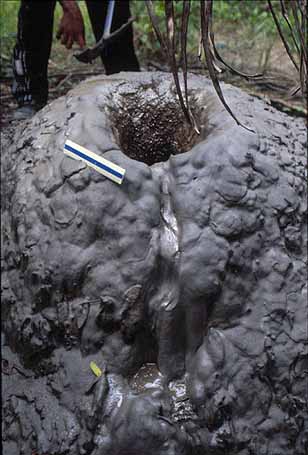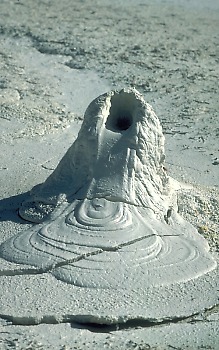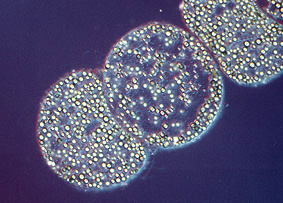
New discovery
of hydrocarbon-derived chimneys in the Gulf of Cádiz
Descubrimiento
de chimeneas submarinas de hidrocarburos en el Golfo de Cádiz
Anastasya/2000
cruise aboard R/V "Cornide de Saavedra"; September 2000
Diaz-del-Rio V., Somoza L., Martinez-Frias J., Hernandez-Molina F.J., Lunar, R., Fernandez-Puga M.C. , Maestro A. , Terrinha P., Llave E., Garcia A., Garcia A. C. and J.T. Vazquez. (2001). Carbonate chimneys in the Gulf of Cadiz: Initial report of their petrography and geochemistry. In: Akhmanov, G. and Suzyumov, A. (eds.), Geological processes on deep-water European margins. IOC-UNESCO Workshop Report 175: pp. 53-54.
 Dolomite
chimneys associated with hydrocarbon-rich fluid venting was discovered
September 2000, as part of the TASYO project (Marine and Science Technology
Spanish Programme) in the Gulf of Cadiz. The unexpected discovery occurred
during the cruise Anastasya/2000 aboard of research vessel Cornide de Saavedra
dredging a 870m-deep and 120m-tall carbonate mound called as the "Iberico".
A suite of more than 60 individual structures of chimneys were collected,
which displays distinct pipe-like morphologies that varies from 1 to 0.40
m long. Fragments of chimneys from the Hesperides mud volcanoe within the
Tasyo field and along the Morrocan margin were also sampled. At same time,
in all of these sites, strongly sulfide mud breccia and dolomite slabs
have also been collected.
Dolomite
chimneys associated with hydrocarbon-rich fluid venting was discovered
September 2000, as part of the TASYO project (Marine and Science Technology
Spanish Programme) in the Gulf of Cadiz. The unexpected discovery occurred
during the cruise Anastasya/2000 aboard of research vessel Cornide de Saavedra
dredging a 870m-deep and 120m-tall carbonate mound called as the "Iberico".
A suite of more than 60 individual structures of chimneys were collected,
which displays distinct pipe-like morphologies that varies from 1 to 0.40
m long. Fragments of chimneys from the Hesperides mud volcanoe within the
Tasyo field and along the Morrocan margin were also sampled. At same time,
in all of these sites, strongly sulfide mud breccia and dolomite slabs
have also been collected.
Targets were previously detected in May 2000 by carrying out a detailed mapping and ultra high resolution seismic, with an extent new data of more than 1200 km obtained during the cruise TASYO/2000 aboard of research vessel Hesperides. The Simrad EM12S-120 system, a multibeam echo sounder system, was used for mapping sea-floor. The swath mapping provided bathymetric map contoured at an interval of 1 m also a subsidiary map showing the strength of the sea-floor backscattering of the sonar signal. A Parasound echosounder TOPAS (Topographic Parametric Sound) , which is a sub-bottom profiles was also used.
 The
chimneys are dominated by Fe-riched dolomite (ankerite) forming aggregates
with minor amounts of pyrite, iron oxide, Ta-enriched rutile, zircon and
quartz. Abundant, well preserved remains of foraminifera (globigerinoids
and milioids) composed of Mg-calcite are present within the matrix. Dolomite
aggregrates are remarkably depleted in 13C (-35 to -56 PDB) and are
therefore interpreted being the result of methane oxidation by sulphate-reducing
bacteria. This microbial activity is shown by abundance spheroids to euhedral
pentagonal monocryst composed by up to 60 cells of sulphate-reducing bacteria.
Aggregates of single bacteria of about 1?m diameter produces rounded
to -pentagonal shaped framboids up to 60 ?m characteristics of pyrite.
Presently, mostly these bacterial-origin framboids are replaced by haematite.
At same time, some of framboids have been found in the interior of the
foraminifer chambers, which could suggest some symbiotic association between
foraminifer and chemosyntectic bacteria.
The
chimneys are dominated by Fe-riched dolomite (ankerite) forming aggregates
with minor amounts of pyrite, iron oxide, Ta-enriched rutile, zircon and
quartz. Abundant, well preserved remains of foraminifera (globigerinoids
and milioids) composed of Mg-calcite are present within the matrix. Dolomite
aggregrates are remarkably depleted in 13C (-35 to -56 PDB) and are
therefore interpreted being the result of methane oxidation by sulphate-reducing
bacteria. This microbial activity is shown by abundance spheroids to euhedral
pentagonal monocryst composed by up to 60 cells of sulphate-reducing bacteria.
Aggregates of single bacteria of about 1?m diameter produces rounded
to -pentagonal shaped framboids up to 60 ?m characteristics of pyrite.
Presently, mostly these bacterial-origin framboids are replaced by haematite.
At same time, some of framboids have been found in the interior of the
foraminifer chambers, which could suggest some symbiotic association between
foraminifer and chemosyntectic bacteria.
Dolomite chimneys
are interpreted as cemented conduits formed as result of methane-enriched
fluid expulsion through a submarine mound, probably formed as a mud volcanoe.
The abundant pseudo-pyrite framboids are related with the zone of shallow
microbial sulphate reduction, a process fundamental to the nourishment
of the chemosynthetic cold seep communities. In the last years, it has
been considered the importance of carbonate cementation related with methane
fluxes, both on submarine modern environments and on rocks of the fossil
record. This carbonate cementation, in forms of chimneys, slabs, and crusts
has been reported in several tectonic settings such as the Gulf of Mexico,
Oregon margin, Otago slope, Monterey basin and Kattegat (e.g. Jorgensen,1992;
Orpin 1997; Stakes et al. 1999). Large fluxes of methane seem responsible
for dolomite cementation, instead high-Mg calcite and aragonite when fluxes
are lower. Recently, its has been hypothesis that extensive anerobial microbial
communities exist in sedimentary layers below high-temperatures vent fields.
Chemosyntetic bacteria are the primary producer of hydrothermal producers
that are fuelled by geothermal energy. The sum of the syntrophy cooperation
between methane-oxidisers (archaeobacterias domain) and sulphate-reducers
micro-organism produces carbonates and sulphides at the sulphate-methane
interface, which depth below sea floor is dependent on the methane flux
rate (DeLong 2000)



